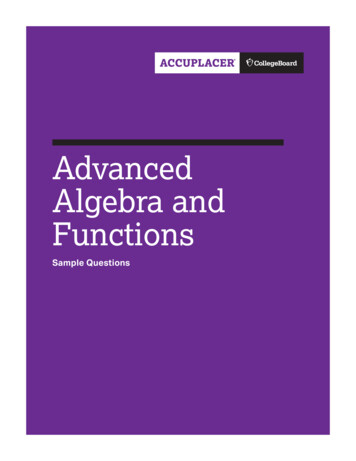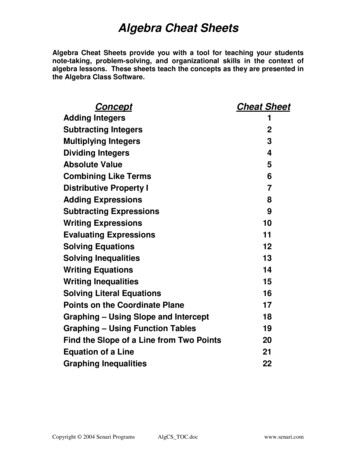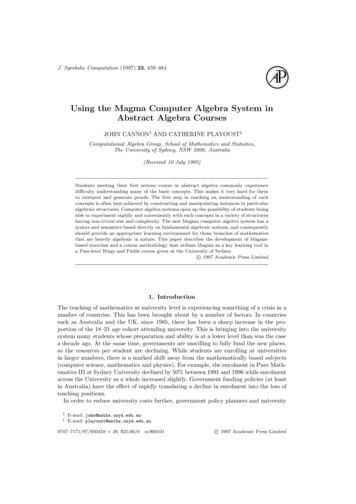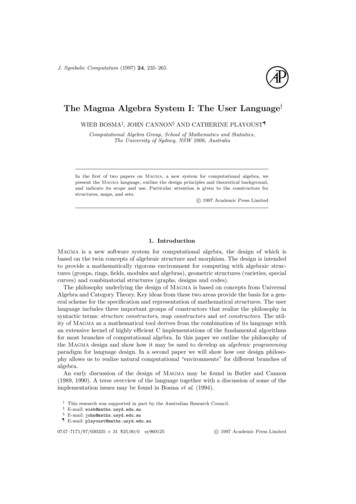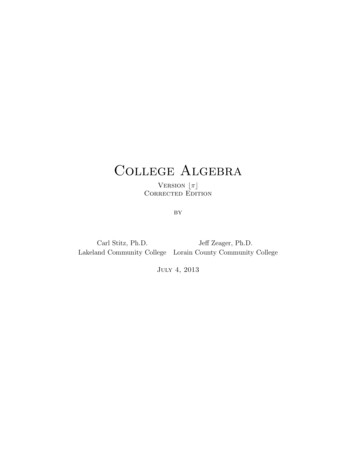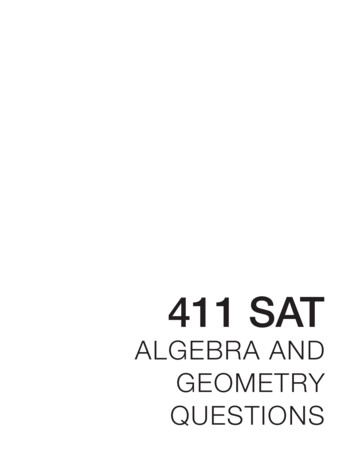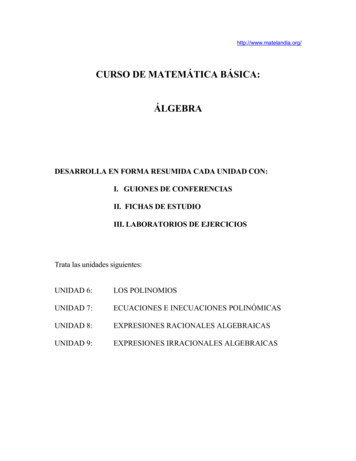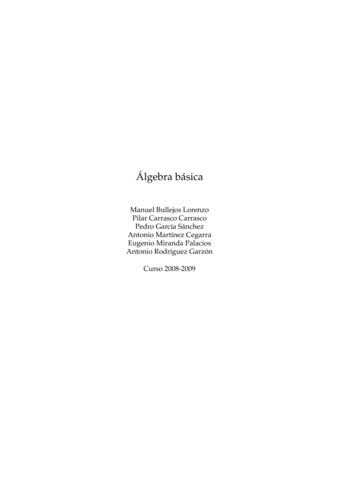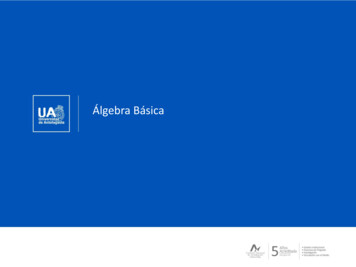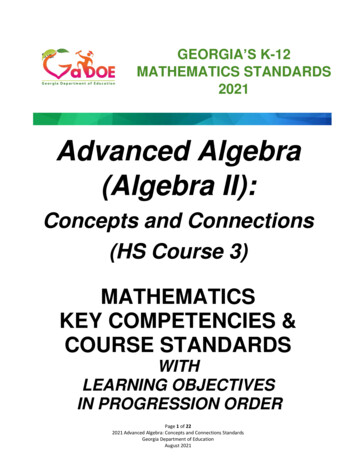
Transcription
floorGEORGIA’S K-12MATHEMATICS STANDARDS2021Advanced Algebra(Algebra II):Concepts and Connections(HS Course 3)MATHEMATICSKEY COMPETENCIES &COURSE STANDARDSWITHLEARNING OBJECTIVESIN PROGRESSION ORDERPage 1 of 222021 Advanced Algebra: Concepts and Connections StandardsGeorgia Department of EducationAugust 2021
GEORGIA’S K-12MATHEMATICS STANDARDS2021Governor Kemp and Superintendent Woods are committed to the best set of academic standardsfor Georgia’s students – laying a strong foundation of the fundamentals, ensuring age- anddevelopmentally appropriate concepts and content, providing instructional supports to set ourteachers up for success, protecting and affirming local control and flexibility regarding the use ofmathematical strategies and methods, and preparing students for life. These Georgia-owned andGeorgia-grown standards leverage the insight, expertise, experience, and efforts of thousands ofGeorgians to deliver the very best educational experience for Georgia's 1.7 million students.In August 2019, Governor Brian Kemp and State School Superintendent Richard Woodsannounced the review and revision of Georgia's K-12 mathematics standards. Georgians havebeen engaged throughout the standards review and revision process through public surveys andworking groups. In addition to educator working groups, surveys, and the Academic ReviewCommittee, Governor Kemp announced a new way for Georgians to provide input on thestandards: the Citizens Review Committee, a group composed of students, parents, business andcommunity leaders, and concerned citizens from across the state. Together, these efforts wereundertaken to ensure Georgians will have buy-in and faith in the process and product.The Citizens Review Committee provided a charge and recommendations to the working groupsof educators who came together to craft the standards, ensuring the result would be usable andfriendly for parents and students in addition to educators. More than 14,000 Georgiansparticipated in the state's public survey from July through September 2019, providing additionalfeedback for educators to review. The process of writing the standards involved more than 200mathematics educators -- from beginning to veteran teachers, representing rural, suburban, andmetro areas of our state.Grade-level teams of mathematics teachers engaged in deep discussions; analyzed stakeholderfeedback; reviewed every single standard, concept, and skill; and provided draftrecommendations. To support fellow mathematics teachers, they also developed learningprogressions to show when key concepts were introduced and how they progressed across gradelevels, provided examples, and defined age/developmentally appropriate expectations.These teachers reinforced that strategies and methods for solving mathematical problems areclassroom decisions -- not state decisions -- and should be made with the best interest of theindividual child in mind. These recommended revisions have been shared with the AcademicReview Committee, which is composed of postsecondary partners, age/development experts,and business leaders, as well as the Citizens Review Committee, for final input and feedback.Based on the recommendation of Superintendent Woods, the State Board of Education will voteto post the draft K-12 mathematics standards for public comment. Following public comment, thestandards will be recommended for adoption, followed by a year of teacher training andprofessional learning prior to implementation.Page 2 of 222021 Advanced Algebra: Concepts and Connections StandardsGeorgia Department of EducationAugust 2021
Advanced Algebra: Concepts & ConnectionsOverviewThis document contains a draft of Georgia’s 2021 K-12 Mathematics Standards for theHigh School Advanced Algebra: Concepts and Connections Course, which is the thirdcourse in the high school course sequence.The standards are organized into big ideas, course competencies/standards, and learningobjectives/expectations. The grade level key competencies represent the standardexpectation of learning for students in each grade level. The competencies/standards areeach followed by more detailed learning objectives that further explain the expectationsfor learning in the specific grade levels.New instructional supports are included, such as clarification of language andexpectations, as well as detailed examples. These have been provided for teachingprofessionals and stakeholders through the Evidence of Student Learning Column thataccompanies each learning objective.Course Description:Advanced Algebra: Concepts & Connections is the culminating course in a sequenceof three high school courses designed to ensure career and college readiness. It isdesigned to prepare students for fourth course options relevant to their career pursuits.High school course content standards are listed by big ideas including Data and StatisticalReasoning, Probabilistic Reasoning, Functional and Graphical Reasoning, Patterningand Algebraic Reasoning, and Geometry Patterning and Spatial Reasoning.This course is designed as the third course in a three-course series. This courseenhances students’ geometric, algebraic, graphical, and probabilistic reasoning skills.Students will apply their algebraic and geometric reasoning skills to make sense ofproblems involving geometry, trigonometry, algebra, probability, and statistics. Studentswill continue to enhance their analytical geometry and reasoning skills when analyzingand applying a deep understanding of polynomial expressions, proofs, constructions, rigidmotions and transformations, similarity, congruence, circles, right triangle trigonometry,geometric measurement, and conditional probability.Prerequisite:This course is designed for students who have successfully completedGeometry: Concepts & Connections.Page 3 of 222021 Advanced Algebra: Concepts and Connections StandardsGeorgia Department of EducationAugust 2021
Georgia’s K-12 Mathematics Standards - 2021Mathematics Big Ideas and Learning Progressions, HighSchoolMathematics Big Ideas, HSHIGH SCHOOLMATHEMATICAL PRACTICES (MP)MATHEMATICAL MODELING (MM)NUMERICAL REASONING (NR)PATTERNING & ALGEBRAIC REASONING (PAR)FUNCTIONAL & GRAPHICAL REASONING (FGR)GEOMETRIC & SPATIAL REASONING (GSR)DATA & STATISTICAL REASONING (DSR)PROBABILISTIC REASONING (PR)The 8 Mathematical Practices and the Mathematical Modeling Frameworkare essential to the implementation of the content standards presented inthis course. More details related to these concepts can be found in the linksbelow and in the first two standards presented in this course:Mathematical PracticesMathematical Modeling FrameworkPage 4 of 222021 Advanced Algebra: Concepts and Connections StandardsGeorgia Department of EducationAugust 2021
Advanced Algebra: Concepts & ConnectionsThe nine course standards listed below are the key content competencies students will be expected to master in this course.Additional clarity and details are provided through the classroom-level learning objectives and evidence of student learningdetails for each course standard found on subsequent pages of this document.COURSE STANDARDSAA.MP: Display perseverance and patience in problem-solving. Demonstrate skills and strategies needed tosucceed in mathematics, including critical thinking, reasoning, and effective collaboration and expression. Seekhelp and apply feedback. Set and monitor goals.AA.MM.1: Apply mathematics to real-life situations; model real-life phenomena using mathematics.AA.DSR.2: Communicate descriptive and inferential statistics by collecting, critiquing, analyzing, and interpretingreal-world data.AA.FGR.3: Explore and analyze structures and patterns for exponential and logarithmic functions and useexponential and logarithmic expressions, equations, and functions to model real-life phenomena.AA.FGR.4: Explore and analyze structures and patterns for radical functions and use radical expressions,equations, and functions to model real-life phenomena.AA.FGR.5: Extend exploration of quadratic solutions to include real and non-real numbers and explore how thesenumbers behave under familiar operations and within real-world situations; create polynomial expressions, solvepolynomial equations, graph polynomial functions, and model real-world phenomena.AA.PAR.6: Represent data with matrices, perform mathematical operations, and solve systems of linear equationsleading to real-world linear programming applications.AA.GSR.7: Develop an introductory understanding of the unit circle; solve trigonometric equations using the unitcircle.AA.FGR.8: Analyze the behaviors of rational functions to model applicable, mathematical problems.Page 5 of 222021 Advanced Algebra: Concepts and Connections StandardsGeorgia Department of EducationAugust 2021
Advanced Algebra: Concepts & ConnectionsMATHEMATICAL MODELINGAA.MM.1: Apply mathematics to real-life situations; model real-life phenomena using mathematics.ExpectationsEvidence of Student Learning(not all inclusive; see Grade Level Overview for more details)AA.MM.1.1Explain applicable, mathematicalproblems using a mathematicalmodel.AA.MM.1.2Create mathematical models toexplain phenomena that exist in thenatural sciences, social sciences,liberal arts, fine and performing arts,and/or humanities contexts.Using abstract and quantitativereasoning, make decisions aboutinformation and data from amathematical, applicable situation.AA.MM.1.3AA.MM.1.4Use various mathematicalrepresentations and structures torepresent and solve real-lifeproblems.Fundamentals Students should be provided with opportunities to learn mathematics in the context ofculturally relevant problems. Mathematically applicable problems are problems presented in context where the contextmakes sense, realistically and mathematically, and allows for students to make decisionsabout how to solve the problem (i.e., model with mathematics).Fundamentals Mathematically proficient students should be able to use the content learned in this courseto create a mathematical model to explain real-life phenomena.Fundamentals Students should be able to:o analyze functions, graphs, tables, andequations and make decisions aboutthe real-life situations they describebased upon their understanding ofmathematical functions.o analyze statistical results to decidethe best course of action or approachto a problem.Example Given a rectangle with length (x – 2)and width (2x 3), a student coulddiscover and articulate that the area (x– 2)(2x 3) 2x2 – x – 6. From thestudent’s understanding of parabolas, astudent would know that the parabolathat represents all possible areas of thisrectangle opens upwards and that thereis no maximum area possible for thisrectangle.Fundamentals Students should be able to generate models, graphs, charts, and equations, to representreal-world phenomena in order to solve problems. Students should be provided opportunities to generate representations of real-worldphenomena utilizing technology to show these phenomena and to solve problems.Page 6 of 222021 Advanced Algebra: Concepts and Connections StandardsGeorgia Department of EducationAugust 2021
DATA & STATISTICAL REASONING – descriptive and inferential statisticsAA.DSR.2: Communicate descriptive and inferential statistics by collecting, critiquing, analyzing, and interpreting realworld dence of Student LearningRecognize the purposes of anddifferences among sample surveys,experiments, and observationalstudies; explain how randomizationrelates to each. Distinguish betweenprimary and secondary data and howit affects the types of conclusions thatcan be drawn.When collecting and considering data,critically evaluate ethics, privacy,potential bias, and confoundingvariables along with their implicationsfor interpretation in answering astatistical investigative question.Implement strategies for organizingand preparing big data sets.Distinguish between populationdistributions, sample datadistributions, and samplingdistributions. Use sample statistics tomake inferences about populationparameters based on a randomsample from that population and tocommunicate conclusions usingappropriate statistical language.(not all inclusive; see Grade Level Overview for more details)Strategies and MethodsExample Students should be provided opportunities Students might design and carry out ato collect data of their own designstudy with a recognition of error in the(primary) and/or use data that alreadydesign of the study.exists (secondary). Students might evaluate a research study Students should be able to critiqueand critique the investigative measuresstudies of different design types andand/or conclusions drawn from the data.explain how randomization relates to eachstyle of investigation.FundamentalsExamplesTerminology Students should be able Students might be provided Messy datato question how dataopportunities to search for dataincludes missingwere collected, rationaleon the internet and prepare itvalues, incorrectfor the study, positionalityby implementing strategies forinputs, lack ofof the researcher,dealing with messy data.representativeness,subjectivity of humandifficult formatting, Students might be provideddecision making, etc.etc.opportunities to search for data Students should be ableon the internet and thento recognize bias andprovide a critical evaluation ofdescribe its potentialthe methods used to collect,effects. They do not needorganize and communicateto memorize definitions ofthat data to the public.”types of bias.FundamentalsStrategies and Methods Students should recognize that it is most often not feasible to Students shouldstudy an entire population distribution. Therefore, studentshave manyshould have opportunities to explore representative samplesopportunities tofrom the population to make inferences concerning thecommunicatepopulation.quantitativeinformation using Students should demonstrate understanding of how samplingstatistical languagedistributions developed through simulation are used toin oral, written, anddescribe the sample-to-sample variability of sample statistics.graphical form to Students should summarize results from statistical analysesbuild data fluency.using appropriate statistical justifications that indicate anunderstanding of the statistics.Page 7 of 222021 Advanced Algebra: Concepts and Connections StandardsGeorgia Department of EducationAugust 2021
AA.DSR.2.4Calculate and interpret z-scores as ameasure of relative standing and as amethod of standardizing units.Fundamentals Students should understand that z-scoresare a statistical tool that allows someoneto compare samples with differing units.Students should have opportunities to usez-scores to make decisions whenanalyzing real-world data. Students should understand that z-scorescan be used with all distributions,regardless of shape. Students should use technology tools tocalculate standard deviation whennecessary to determine z-scores.AA.DSR.2.5Given a normally distributedpopulation, estimate percentagesusing the Empirical Rule, z-scores,and technology.AA.DSR.2.6Model sample-to-sample variability insampling distributions of a statisticusing simulations taken from a givenpopulation.AA.DSR.2.7Given a margin of error, develop andcompare confidence intervals ofdifferent models to make conclusionsabout reliability.AA.DSR.2.8Summarize and evaluate reportsbased on data for appropriateness ofstudy design, analysis methods, andstatistical measures used.FundamentalsStrategies and Methods Students should understand that there are Students should be encouraged to usedata sets for which such a procedure istools such as calculators, spreadsheets,not appropriate because it is not normallyor tables to estimate areas under adistributed.normal curve.FundamentalsExample Students should be able to use Students could involve a simulatedsimulations to decide if a specified modelsampling distribution for a sample meanaccurately reflects real outcomes.or a sample population to decide if aspecified model accurately reflects real Students should be able to consider theoutcomes.sample-to-sample variability by usingstatistics from repeated samples of thesame size.FundamentalsStrategies and Methods Examples Students should be able Students might be Students might compare exitto apply the margin ofprovidedpoll data with two differenterror to make conclusionsopportunities tomargins of error to determineabout the reliability ofdevelop confidenceif the results are conclusive.statistical results.intervals using Students might exploresimulations and Students do not have toquestions such as: “In atechnology, such ascalculate the margin offavorability poll, if a politicianstatistical applets.error.has a 52% approval rating 5points, can they claim thatmost people approve?”Fundamentals Students should be able to communicate statistical information using written and oralreports.Page 8 of 222021 Advanced Algebra: Concepts and Connections StandardsGeorgia Department of EducationAugust 2021Example Students might compare performance onSAT versus ACT despite the differentscoring scales by using z-scores.
FUNCTIONAL & GRAPHICAL REASONING – exponential and logarithmic functionsAA.FGR.3: Explore and analyze structures and patterns for exponential and logarithmic functions and use exponential andlogarithmic expressions, equations, and functions to model real-life phenomena.ExpectationsEvidence of Student LearningAA.FGR.3.1Find the inverse of exponential andlogarithmic functions using equations,tables, and graphs, limiting the domainof inverses where necessary tomaintain functionality, and prove bycomposition or verify by inspection thatone function is the inverse of another.AA.FGR.3.2Analyze, graph, and compareexponential and logarithmic functions.AA.FGR.3.3Use the definition of a logarithm,logarithmic properties, and the inverserelationship between exponential andlogarithmic functions to solve problemsin context.Create exponential equations and uselogarithms to solve mathematical,applicable problems for which only onevariable is unknown.AA.FGR.3.4(not all inclusive; see Grade Level Overview for more details)Strategies and MethodsTerminology To verify by inspection, students can compare graphs of two To prove byrelations and show that one is the reflection of the othercomposition meansacross the line y x.to determine iff(g(x)) g(f(x)) x. To verify by inspection, students can show that one table orset of coordinates is the inverse of another because the yvalues of the first are the x-values of the second and viceversa. To verify by inspection, students can show that a series ofoperations upon input values of one function are opposite andreversed in order for a second function. Students should be able to prove by composition that twofunctions are inverses of each other.Fundamentals Students should be able to graph and identify key features of exponential and logarithmicfunctions, including domain, range, and x- and y-intercepts; roots, zeros, and solutions;asymptotes; interval(s) where the function is positive, and/or negative; non-symmetry; endbehavior. Students should be able to calculate the average rate of change for a given interval,including the estimated rate of change. Students should have opportunities to gain an intuitive sense into what happens to thegraph or model as a result of changes to the various key features of the function.Fundamentals Students should be given opportunities to solve real-life, culturally relevant problemsinvolving the use of the common logarithm and the natural logarithm. Students should be able to apply their knowledge of the inverse relationship betweenexponential and logarithmic functions to solve real-life problems.Fundamentals Students should be able to solve problemsinvolving exponential equations using therelationship with logarithmic functions tosolve for the single unknown variable. Given pertinent information (e.g., ambienttemperature and time), students should beable to use exponential equations to solvereal-life problems and interpret the solutions.Page 9 of 222021 Advanced Algebra: Concepts and Connections StandardsGeorgia Department of EducationAugust 2021Examples Students can solve and interpretequations that have one unknownvariable, such as:o Exponential growtho Compound interesto Newton’s Law of Cooling:T(t) TS (T0 - TS) e-kt
AA.FGR.3.5Create and interpret logarithmicequations in one variable and usethem to solve problems.AA.FGR.3.6Create, interpret, and solveexponential equations to representrelationships between quantities andanalyze the relationships numericallywith tables, algebraically, andgraphically.AA.FGR.3.7Create, interpret, and solve logarithmicequations in two or more variables torepresent relationships betweenquantities.FundamentalsExample Given pertinent information, students Students can create and interpretshould be able to use logarithmicequations involving pH, such as pH equations to solve real-life problems andlog(H ), to define the acidity or alkalinityinterpret the solutions.of a substance.FundamentalsExamples Students should be able to analyze what Students can create, interpret and solveis happening in the relationships betweenequations that have two unknownquantities.variables, such as:o Half-Life Students should discuss theo Exponential growthcharacteristics of exponential functions ino Exponential decaycontext, including domain and range,o Compound interestzeros, intercepts, average rate of change,o Newton’s Law of Cooling:asymptote, and other relevant keyT(t) TS (T0 - TS) e-ktfeatures. Students should be able to solve real-lifeproblems that can be modeled byexponential equations. Students should be encouraged toexplore multiple solution pathways, whichmight include graphing with various tools,interpreting key features, and evaluatingequations.FundamentalsExample Students should be able to analyze and interpret logarithmic Students are able toequations presented in mathematical, applicable situations.create and interpretequations involving Students should discuss the characteristics of logarithmiclogarithms such asfunctions in context, including domain and range, zeros,the equation for theintercepts, average rate of change, asymptote, and othermagnitude of anrelevant key features.earthquakes M Students should be able to solve problems that can belog10 (I/S).modeled by logarithmic equations. Students should be encouraged to explore multiple solutionpathways, which might include graphing with various tools,interpreting key features, and evaluating equations.Page 10 of 222021 Advanced Algebra: Concepts and Connections StandardsGeorgia Department of EducationAugust 2021
FUNCTIONAL & GRAPHICAL REASONING – radical functionsAA.FGR.4: Explore and analyze structures and patterns for radical functions and use radical expressions, equations, andfunctions to model real-life phenomena.ExpectationsEvidence of Student Learning(not all inclusive; see Grade Level Overview for more details)AA.FGR.4.1Rewrite radical expressions asexpressions with rational exponents.Extend the properties of integerexponents to rational exponents.Fundamentals In previous grades, students should have developed an understanding of theproperties of integer exponents. Students should be able to convert back and forth between radical expressions andexpressions with rational exponents. Students should be able to recognize that𝑥 AA.FGR.4.2Solve radical equations in one variable,and give examples showing howextraneous solutions may arise.AA.FGR.4.3Analyze and graph radical functions.AA.FGR.4.4Create, interpret and solve radicalequations with one unknown value anduse them to solve problems that modelreal-world situations.𝑥𝑛 𝑏 𝑛 ( 𝑏)𝑛 𝑏 𝑥Students will utilize the product rule, quotient rule, and power rule to work withexpressions with rational exponents.FundamentalsStrategies and MethodsExample Students should be able to Students should have Given thevolume of aconvert between radicalopportunities to usesphere, studentsexpressions and expressionstechnology and tools tocould determinewith rational exponents tosolve radical equations bythe radius of thesolve equations.graphing.sphere by Students should understand Students should havewriting anhow to use substitution toopportunities to useequation for thecheck answers to radicaltechnology and tools toradius, r, andequations to ensure thatexplore and solve radicalsolving for r.solutions are not extraneous.equations to strengthenconceptual understanding.Fundamentals Students should be able to graph and identify key features of a radical functionincluding: domain, range, and x and y-intercepts; roots, zeros, and solutions; intervalswhere the function is increasing, decreasing, positive, and/or negative; maximum andminimum values, including endpoint extrema; non-symmetry; end behavior. Students should be able to calculate the slope of average rate of change for a giveninterval, including the estimated rate of change. Students should be able to relate the key features of a model (i.e., graph, equation,table) to the real-world situation which the model represents.FundamentalsStrategies and MethodsExample Students should be able to Students should have Students canopportunities to usecreate a radicalanalyze and interpret radicaltechnology and tools toequation usingequations presented insolveradicalequationstothe distancemathematical, applicableformula, forsituations.Page 11 of 222021 Advanced Algebra: Concepts and Connections StandardsGeorgia Department of EducationAugust 2021
AA.FGR.4.5Create, interpret, and solve radicalequations in two or more variables torepresent relationships betweenquantities.Students should discuss thecharacteristics of radicalfunctions in context, includingdomain and range, zeros,intercepts, and other relevantkey features.Students should be able tosolve problems that can bemodeled by radical equations. strengthen conceptualunderstanding.Students should beencouraged to exploremultiple solution pathways,which might includegraphing with varioustools, interpreting keyfeatures, and evaluatingradical equations.Strategies and Methods Less time should be devoted to themechanics of solving radical equations andmore time should be devoted to buildingstudents’ capacity for interpreting radicalfunctions within context.which thedistance andthree of the fourcoordinatevalues areknown, and oneis unknown.Example Students can create and interpretproblems involving radical equationsin which two of the variables areunknown, such as problems involvingvelocity.FUNCTIONAL & GRAPHICAL REASONING – polynomial functionsAA.FGR.5: Extend exploration of quadratic solutions to include real and non-real numbers and explore how thesenumbers behave under familiar operations and within real-world situations; create polynomial expressions, solvepolynomial equations, graph polynomial functions, and model real-world phenomena.ExpectationsEvidence of Student Learning(not all inclusive; see Grade Level Overview for more details)AA.FGR.5.1Graph and analyze quadratic functionsin contextual situations and includeanalysis of data sets with regressions.Fundamentals As an introduction to polynomial functions, students should be able to use quadraticfunctions in standard, factored, and vertex forms to graph and identify key features incontext in order to answer questions about real-life phenomena. Key features of quadratic functions should include x and y-intercepts, roots, zeros, andsolutions; domain, range, and intervals where the function is increasing, decreasing,positive, and/or negative (using inequality and interval notations); vertex, extreme value,and axis of symmetry; end behavior, using technology where appropriate. Students should be able to calculate the slope of average rate of change for a giveninterval, including the estimated rate of change. Through contextual exploration, students should recognize that there are data sets forwhich a quadratic function is not the best model, and therefore, explore other types ofpolynomial regression. Analysis of data sets with regressions should be done informally with verbal descriptionsand with the use of technology.Page 12 of 222021 Advanced Algebra: Concepts and Connections StandardsGeorgia Department of EducationAugust 2021
AA.FGR.5.2Define complex numbers i such that i2 –1 and show that every complexnumber has the form a bi where aand b are real numbers and that thecomplex conjugate is a - bi.AA.FGR.5.3Use the relation i2 –1 and thecommutative, associative, anddistributive properties to add, subtract,and multiply complex numbers.Use the structure of an expression tofactor quadratics.AA.FGR.5.4AA.FGR.5.5Write and solve quadratic equationsand inequalities with real coefficientsand use the solution to explain amathematical, applicable situation.Fundamentals Students should be able to identify the real part of a complex number and the imaginarypart. Students should convert any power of the imaginary unit, i, to an equivalent form andidentify the pattern that emerges. Students should have opportunities to identify the complex conjugate of any complexnumber and recognize that complex numbers always occur as pairs when they representsolutions to a polynomial function.Fundamentals Students should be provided opportunities to solve real-life problems that require theaddition, subtraction, or multiplication of complex numbers. Division of complex numbers is beyond the scope of Advanced Algebra.Relevance and Application Expressions should include special-case quadratics such as perfect-square trinomials andthe difference of two perfect squares.Relevance andFundamentalsStrategies andExampleApplicationMethods In previous grades, Students Equationsstudents had Students shouldcan createandopportunities to createbe able to solveequationsinequalitiesand solve quadraticquadraticinvolvingpresented inequations. Given a realequations andareas usingreal-life,l
mathematical strategies and methods, and preparing students for life. These Georgia-owned and Georgia-grown standards leverage the insight, expertise, experience, and efforts of thousands of . Advanced Algebra: Concepts
